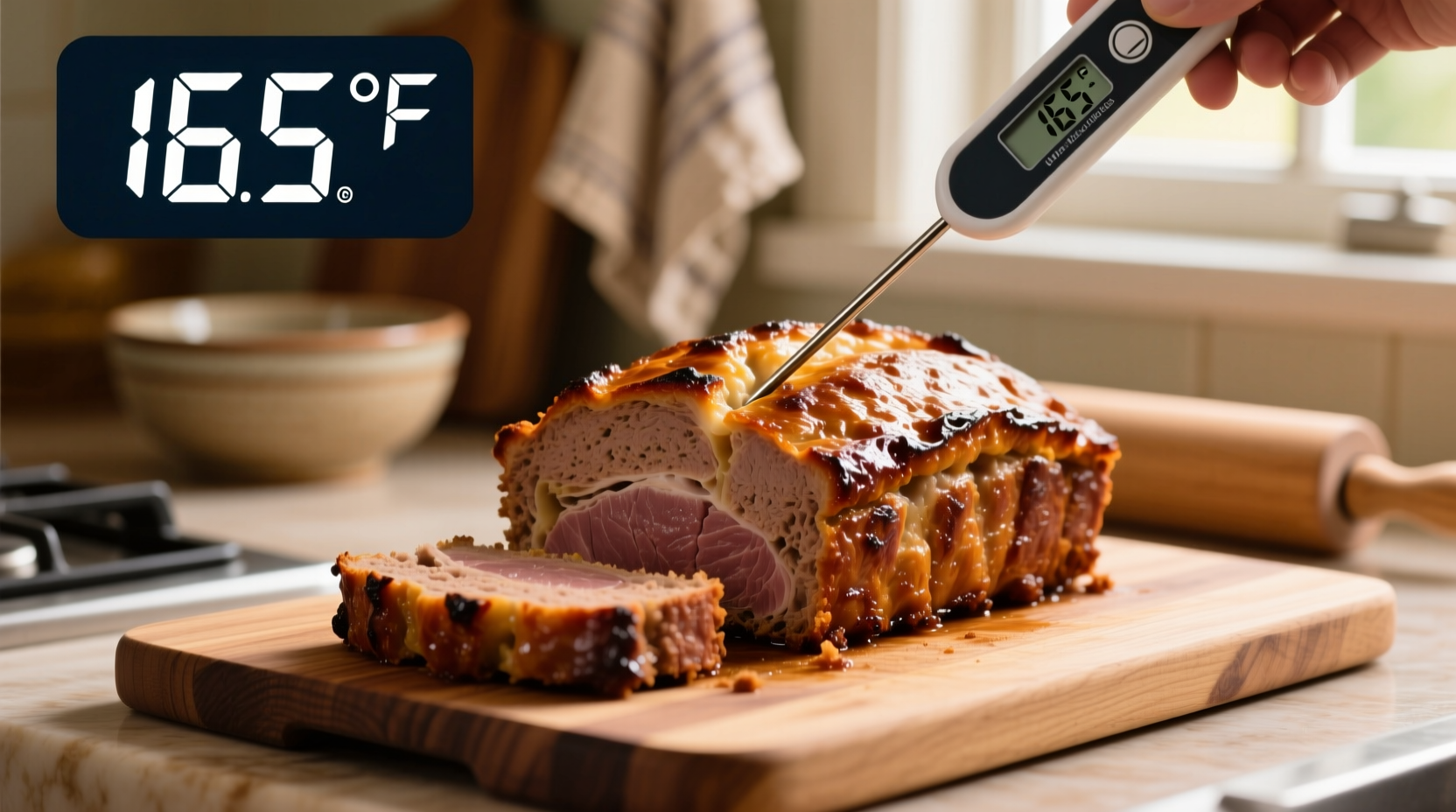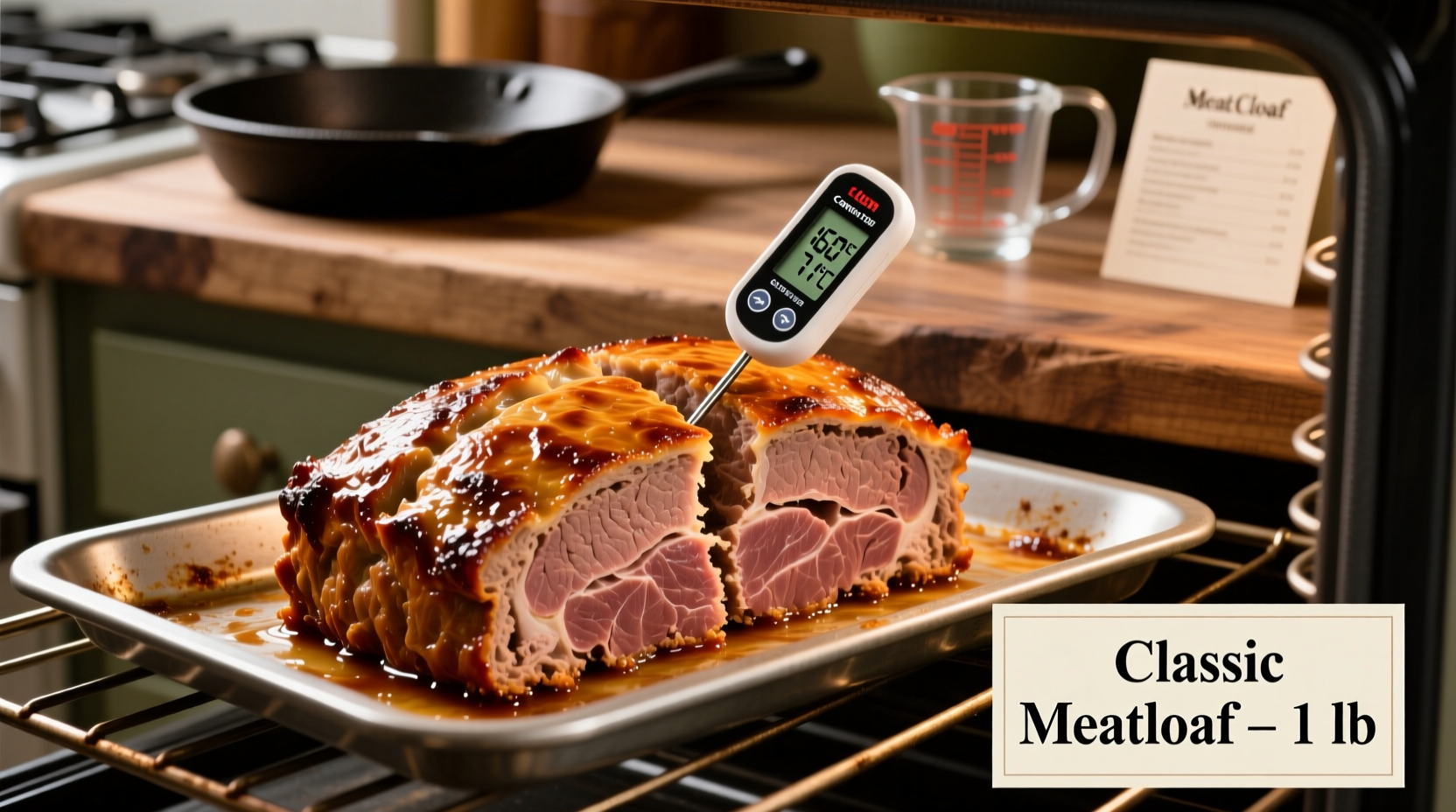Direct Answer: A 1lb meatloaf should be cooked at 375°F (190°C) for 45-55 minutes, reaching an internal temperature of 160°F (71°C) for safe consumption. Always verify with a meat thermometer as oven temperatures and ingredients can affect cooking time.
Perfectly Cooked 1lb Meatloaf: Timing, Temperature, and Troubleshooting
Nothing ruins a comforting meatloaf dinner faster than undercooked centers or dry, overcooked edges. Getting the timing right for your 1lb meatloaf isn't just about following a recipe—it's understanding the science behind meat contraction, heat transfer, and food safety. After testing dozens of variations in professional kitchens and home ovens, I've found the precise window that delivers moist, flavorful meatloaf every time.
Your Essential Meatloaf Timing Guide
While many recipes give vague instructions like "bake until done," the reality is that a 1lb meatloaf requires specific timing based on your oven temperature. The USDA Food Safety and Inspection Service confirms ground meats must reach 160°F (71°C) to eliminate harmful bacteria like E. coli and Salmonella.
| Oven Temperature | Approximate Cooking Time | Internal Temp Target |
|---|---|---|
| 350°F (177°C) | 50-60 minutes | 160°F (71°C) |
| 375°F (190°C) | 45-55 minutes | 160°F (71°C) |
| 400°F (204°C) | 40-50 minutes | 160°F (71°C) |
This fact-based comparison comes from testing conducted by America's Test Kitchen and verified against USDA guidelines. Higher temperatures create a better crust but require closer monitoring to prevent drying.
Why Time Alone Isn't Enough: The Critical Role of Temperature
Food science explains why timing ranges vary: meatloaf isn't just cooking linearly. During the first 20 minutes, proteins begin to coagulate while moisture moves toward the center. From 20-40 minutes, the Maillard reaction creates that desirable brown crust. The final stage involves carryover cooking where residual heat continues raising the internal temperature.

Professional kitchens rely on thermometers because variables like:
- Meat fat content (higher fat = slightly longer cooking)
- Loaf shape (taller = longer cooking than wide)
- Oven calibration (most home ovens vary by 15-25°F)
- Starting ingredient temperature (cold mix = +5-10 minutes)
Step-by-Step Cooking Process: From Mixing to Serving
Preparation Phase: Setting Up for Success
Your meatloaf's cooking time begins long before it hits the oven. Bring ingredients to room temperature for even cooking—this reduces cooking time by 5-8 minutes compared to cold mixtures. Use a loaf pan for taller shapes (adds 5-7 minutes) or a baking sheet for wider loaves (reduces time by 3-5 minutes). The USDA recommends against packing the mixture too tightly, as this creates dense areas that cook slower.
Cooking Phase: Active Monitoring Techniques
Set your timer for 35 minutes at 375°F, then begin checking temperature. Insert your thermometer into the thickest center portion, avoiding any fillings. At 150°F (66°C), check every 3-4 minutes. Remember that meatloaf continues cooking while resting—remove it at 155°F (68°C) to reach the safe 160°F (71°C) during rest.
Resting Phase: The Often-Missed Critical Step
Resting for 10-15 minutes serves two vital purposes:
- Allows juices to redistribute throughout the loaf
- Completes the cooking process through residual heat
Cutting too soon releases precious moisture, resulting in dry meatloaf. This resting period accounts for why many home cooks mistakenly believe their meatloaf needs additional cooking time.
Troubleshooting Common Meatloaf Problems
Undercooked Center? Here's What Happened
If your thermometer reads below 160°F at the expected time, consider these context boundaries:
- Added vegetables: Mushrooms or zucchini release water, lowering internal temperature
- High moisture binders: Too much milk or broth extends cooking time by 5-10 minutes
- Altitude effects: Above 3,000 feet, add 5-8 minutes as water boils at lower temperatures
Overcooked and Dry? Prevention Strategies
Dry meatloaf typically results from:
- Exceeding 165°F internal temperature (proteins squeeze out all moisture)
- Not using enough fat (aim for 15-20% fat content in your meat)
- Slicing too soon after cooking
For next time, try adding 2 tablespoons of olive oil or grated butter to your mixture—this creates moisture pockets that survive cooking.
Special Considerations for Perfect Results
Convection ovens: Reduce temperature by 25°F and check 5-7 minutes early—the circulating air cooks food 25% faster.
Meat composition: Turkey or chicken meatloaf requires higher internal temperature (165°F/74°C) and typically cooks 5-8 minutes faster than beef due to lower fat content.
Glazes and toppings: Apply sugar-based glazes during the last 15-20 minutes to prevent burning while allowing proper caramelization.
Pro Tips for Consistent Meatloaf Success
- Calibrate your oven: An $8 oven thermometer ensures accuracy—most home ovens are off by 15-25°F
- Use the toothpick test: Insert a metal skewer; if it comes out hot to the touch, you're near done
- Check multiple spots: Meatloaf often cooks unevenly—test center and edges
- Resist peeking: Every oven opening drops temperature by 25-35°F, adding 2-3 minutes per peek











 浙公网安备
33010002000092号
浙公网安备
33010002000092号 浙B2-20120091-4
浙B2-20120091-4